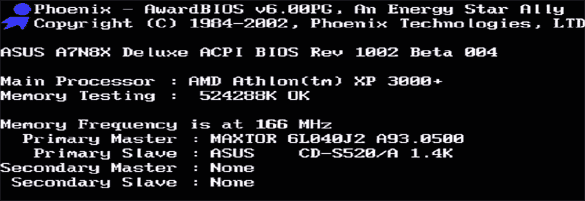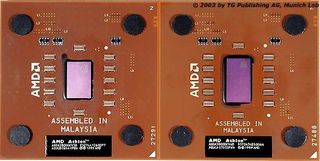Barton's Here: Athlon XP 3000+ vs. P4 3.06 GHz
Architecture's Last Gasp: Athlon XP 3000+ With More Cache, Continued
For the five-year anniversary of the processor, AMD once again adds fuel to the fire: the sixth stage of Athlon's evolution, in the form of the Barton core, is now equipped with an L2 cache that is double the size of its four predecessors for the socket platform. As you know, the first Athlon for slot A was also equipped with a 512 kB L2 cache, only it ran with a maximum of two-thirds of the core clock rate and was located externally on the CPU board.

The new processor is only identified by the motherboard after the BIOS has been updated - a chipset with a 166 MHz FSB rate is a prerequisite.

AMD Athlon XP - old vs. new: the Thoroughbred "B", left, and the Barton, right.
Insiders have long known that, fundamentally, the design of the AMD Athlon is not intended for extremely high clock speeds, but clock increases have currently gone higher than 300 percent (XP 3000+ with 2166 MHz) - if you go back and compare this to the 500 MHz of the first slot A Pluto core.
This deserves a measure of respect because, it is quite an achievement. Seen from the same perspective, Intel's P4 would have to reach 5.2 GHz (compared to its original 1.3 GHz clock rate). That's why it is no secret that the Thoroughbred "B" (for the XP 2800 variant, for example) made production difficult, because only hand-picked and specially labeled samples reached the press.
As early as Oct. 1, 2002, in AMD Travels Through Time: Athlon XP 2800+ with Dual-DDR , we tested the XP 2800+, and we saw Intel react promptly with the P4 with 3.06 GHz and HT technology. AMD has had its hand forced, making this a critical time for the XP 3000+ to arrive on the scene. However, the Barton, now Athlon's top version, works with a lower clock rate than the XP 2800+ on a Thoroughbred B basis.
A look at the AMD data sheet shows that doubling the L2 cache will add a model rating of 300 points, as the Athlon XP 2700+ works at the same speed as the XP 3000+. We thought this was significant and have conducted very comprehensive examinations and tests relating to this.
Stay on the Cutting Edge
Join the experts who read Tom's Hardware for the inside track on enthusiast PC tech news — and have for over 25 years. We'll send breaking news and in-depth reviews of CPUs, GPUs, AI, maker hardware and more straight to your inbox.

In almost five years of evolution, seven Athlon cores were produced. Of these, five CPUs were for the socket A platform. The picture shows the main steps in the evolution from the Thunderbird to the Barton.
Current page: Architecture's Last Gasp: Athlon XP 3000+ With More Cache, Continued
Prev Page Architecture's Last Gasp: Athlon XP 3000+ With More Cache Next Page New CPUs With Barton Core: Athlon XP 2500+/ 2800+/ 3000+Most Popular

